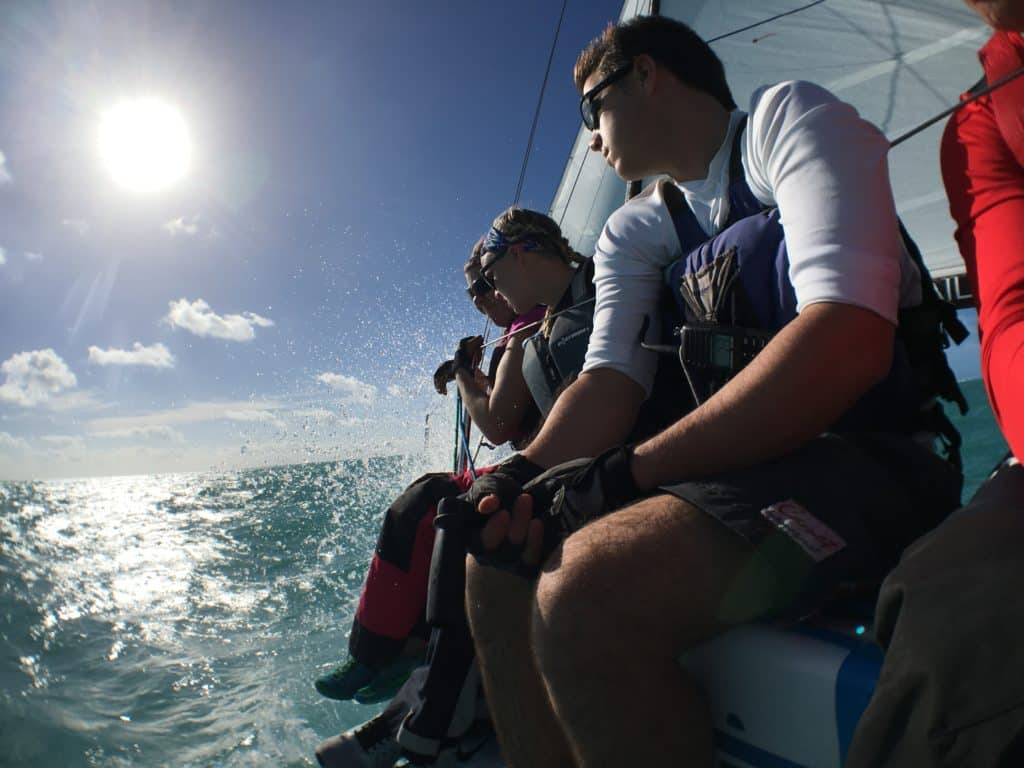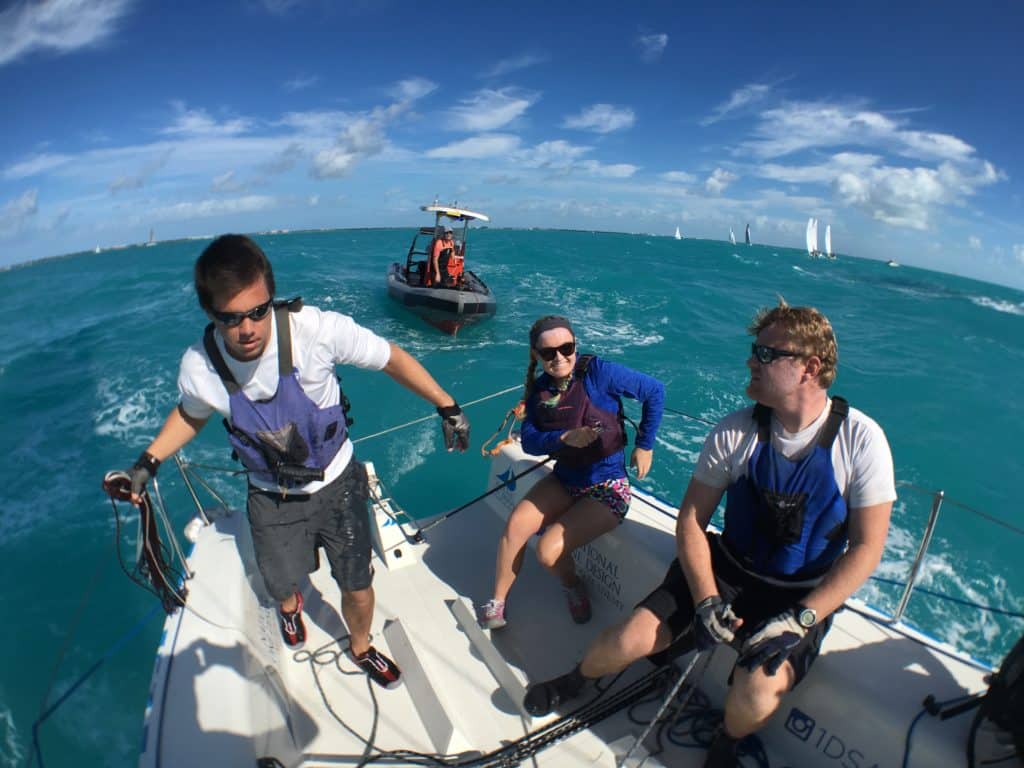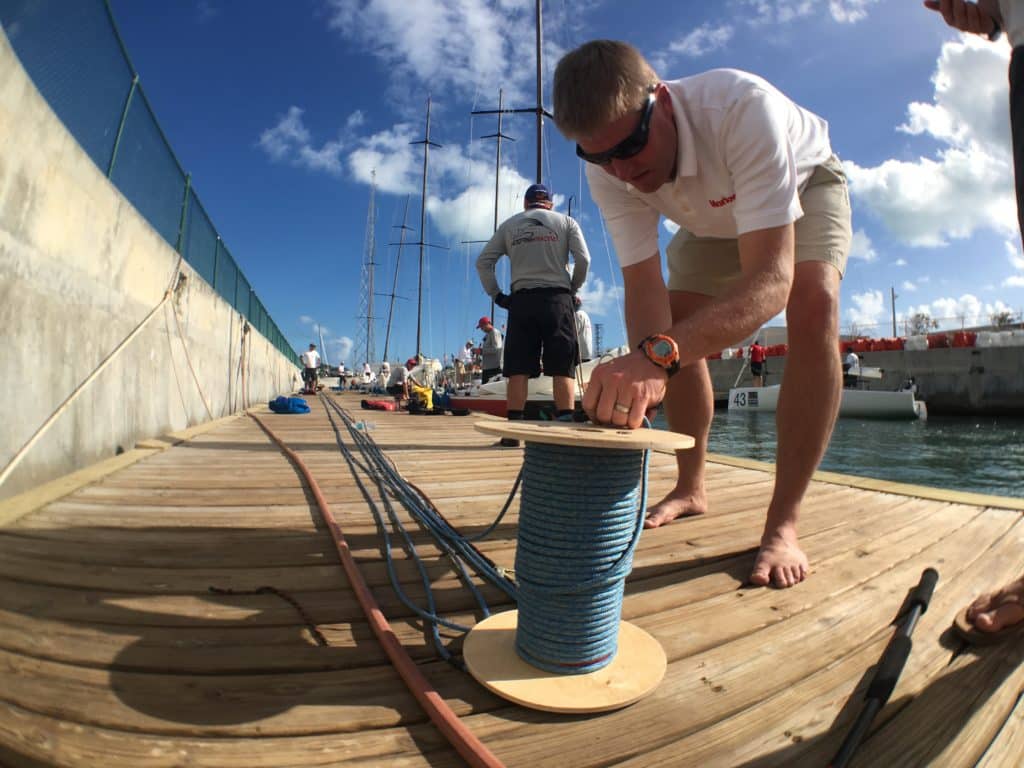
The morning commute is a long one: an hour and half, straight upwind, against a lumpy turquoise flood tide. But for the six of us on Flying Tiger 7.5 No. 10, the morning rush hour drive from Key West’s Truman Annex to Quantum Key West Race Week’s Division 3 circle is a perfect time to get in the groove with the breeze and the wave angles, and to check in with a few others in our seven-boat class.
But it’s a grind of a commute, and today, en route for the first day of races, we made the most of it on No. 10 (now renamed Easy Tiger), which is owned by Toronto’s National One-Design Sailing Academy. They trailered the entire fleet down from Toronto, pulling them from Atlanta behind RVs and put them up for charter boats. With a partnership with Bill Gladstone’s excellent NorthU clinics, some teams have rolled into NorthU’s Regatta Experience – two days of clinics followed by a week of racing with coaches on board and morning and nightly debriefs after racing.
Not everyone has coaches, and no one team is alike alike. Some squads have sailed together on other boats, some have come together through NorthU’s pairing, and one team picked up a charter at the last minute because the Melges 24 fleet didn’t have enough boats to get its own start in Key West.
Easy Tiger came together only days ago when the helm was offered to University of Rhode Island junior Rachel Bryer and paired up with Alabaman sailing couple Mays Dicky and Laura Graham who met at a Thistle regatta awhile ago. Aspiring pro sailor Beth Whitener is sandwiched on the rail between myself and the boat’s assigned coach Mike Marshall, the reigning J/22 world champ and Rolex Yachtsman of the Year nominee.
He’s essentially the adult supervision, and thankfully for us, he doesn’t mind a few trips up an uncoated carbon rig. Ok, maybe he does mind. His second climb this afternoon, we hope, will be his last.

Using our commute as our first chance to sail together as a complete team, we focus straight away on boatspeed through the waves. Rachel is smooth through the waves; up on the front; down on the back, while Mays gets a feel for what it’ll be like pumping the heavily loaded mainsheet as it creaks through the Harken blocks. I love calling breeze, so raise my hand and work on feeding intel to Rachel and Mays … “puff in three…two…one…” “Flat spot here…” I find it’s the best job on the boat because it keeps my head in the game all day long, and keeps me looking upwind to enjoy the view.
Mike is our reality check in the middle; reminding Rachel when the “rail gets squishy,” or we’re too heeled over. Upwind Beth is calling waves and breeze, too, and assisting Laura through the tacks. The sun is blazing, the occasional splashes are cooling, and we were making good pace against any of the other boats around us.
We’re feeling confident in our speed and show up to the starting line on time, check in with the race committee, and start our real upwind work on the course. The plan is to sail the first beat, set the kite, knock off a few blow-through jibes, and then chill. Textbook stuff. Seconds after we sheet the jib on … bang! The jib halyard blows up at the cam cleat.
Ruh-roh.
In any other class, we would’ve been toast…another hour back to the dock and only two races planned, there isn’t enough time, but the Academy’s roving support boat is quickly alongside us. We pass them our dearly departed halyard and waited while they splice it back together.
One by one the preceding classes go off on time. We’re fifth in the sequence so while there isn’t any urgency, it isn’t the end of the day. Maybe we miss the first race, but not all is lost. When our pennants start going up and down, however, and we’re looking at minutes to spare, we’re watching our chances slip away.
At 4 minutes, Mike’s finally taping the repaired halyard and to tracer line and up it goes…we’re still in this. We’ll make it, I think to myself, but I look up and see Mike struggling to get the halyard out of the exit. It’s stuck. It won’t go up or down.

He grimaces, says to no one, “Well…only one thing to do,” and tugs down on the orange tracer line, which goes limp in his hand. Next, he’s staring at the bitter end in his hand and knows we’re screwed.
Retiring before we even get chance to start a single race is a horrible way to begin, and a serious bummer, but it’s a long week and we’ll get back into it. So, we turn for the barn, set the fun sail and work on our wing-on-wing technique. At least we didn’t have to beat our way home in rush hour traffic.
At the dock, up the rig Mike goes with a tracer line and stack of stainless steel nuts. The search for a replacement halyard isn’t going well. Our first call, to Sam Vinyard from Marlow Ropes is a bust: he doesn’t have any inventory for us to dip into. Then, who saunters down the dock to save say hello, but ultimately save our bacon?
New England Ropes’ Kevin Coughlin. Just happen to be strolling through the Annex.
He’s got a spool.
An hour later, Mike is measuring out new jib halyards for the entire fleet (we’re not the only one to have a failure, we later learn), and Vinyard is volunteering to cut, melt, thread and run all of them. Now that’s some outstanding industry service. Above and beyond, but that’s what good guys do to make sure no boat gets left at the dock.
So, while we were a bit of sacrificial lamb in the Tiger fleet, everyone else can now rest easy for tomorrow knowing their jib halyards are tight and strong. For us, Day 2 is now Day 1.









